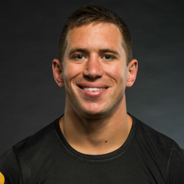
“The five guys going to the Games deserve it.”


Two years, two seventh-place finishes.
Although 2013 was a repeat of 2012 for Gerald Sasser, something was different.
“I felt like I belonged,” he says.
In the past, the other Central East athletes intimidated him.
“You put them on a pedestal, you don’t think you could beat them,” he says.
With 2010 CrossFit Games champion Graham Holmberg to his right, and two-time reigning Games champion Rich Froning Jr. to his left, the Central East Regional feels less like a qualifying round and more like the final event at the CrossFit Games. Not to mention top Games athletes Dan Bailey, Scott Panchik and Marcus Hendren.
As the seventh-ranked man in the world’s most competitive region, it’s difficult for Sasser since he can see the Mid Atlantic Region from his bedroom window.
“You can throw a rock and hit West Virginia,” he says.
Assuming he would have gone just as hard in the Mid Atlantic as he did in the Central East, he would have qualified for the Games.
Event 1: 5:17 (Central East: sixth/Mid Atlantic: third)
Event 2: 295.3 (Central East: third/Mid Atlantic: second)
Event 3: 4:48.5 (Central East: fifth/Mid Atlantic: fourth)
Event 4: 23:46.0 (Central East: sixth/Mid Atlantic: second)
Event 5: 4:41.3 (Central East: ninth/Mid Atlantic: 11th)
Event 6: 11:57.0 (Central East: 14th/Mid Atlantic: 13th)
Event 7: 4:21.2 (Central East: sixth/Mid Atlantic: third)
Central East point total: 49 (seventh overall)
Mid Atlantic point total: 38 (second overall)
If Sasser competed across the Ohio River, he would have stood on the podium next to Ben Smith and Gary Helmick. This weekend, he would be packing his bags for Carson, Calif.
He knows things could play out differently in another region, but he’s not willing to leave CrossFit Countdown in Ashland, Ky.
“If I made it to the Games that way, it would drive me crazy to hear ‘Gerald Sasser’ from some other gym that’s not mine,” he says.
Since he won’t move, all he can do is train.
“Everything went how I wanted it to ... except my placings,” he says. “I'm not good enough yet.”
The handstand push-ups and lunges from Event 6 remind him of that. In the final heat, he was almost the last competitor off the 50 handstand push-ups at 3:48. Before Sasser started in on the 30 toes-to-bars, Dan Bailey was already one movement ahead, axle bar in hand.
“I thought I could win that one,” he says. “I also thought I had strong legs.”
Several 160-lb. axle bar drops later, he stepped on the finish mat at 11:57 for 14th place.
An extra five points was the difference between qualifying and staying home. Marcus Hendren got the last qualifying spot with 44 points. Sasser took seventh with 49.
Although a different finish on Event 4 could have locked in a Games spot, he doesn’t dwell on it.
“I wasn’t disappointed,” he says. “The five guys going to the Games deserve it.”
For the next year, he plans to further refine his training, and stick to the Outlaw programming, which he has followed for nearly a year.
Sasser’s training days entail a single session lasting around two-and-a-half hours. He usually starts with a skill, like a three-position snatch, he says. Then, percentages from a squat cycle and constantly varied conditioning work.
He’s learned he needs to toss the breaks. When studying his competition, he didn’t notice anything special until the third day of the Regional. As he drifted behind the top athletes, the difference between him and them became apparent.
“My breaks are longer,” he says.
To fix that, he has added new efforts to his programming, like running.
“I know there was no running (at Regionals), but I think I will run more this year,” he says.
With a refined approach, Sasser hopes to get out of the Central East Region in 2014 and earn his ticket to the Games.






